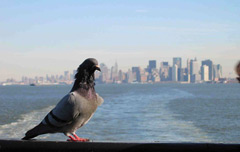
Gateways to the World: Port of New York
•Broadcast Premiere: ARTE May 2006
| Production: | ma.ja.de. filmproduktion |
| Year: | 2005 |
| Genre: | Part 1 of 5 Documentary Series |
| Length: | 60 min |
| Format: | DigiBeta |
Synopsis
There is no other port in the world that is associated with so much longing for a better life than the New York Harbor. There is a famous New York saying that there are "eight million stories in the naked city," and all of them start right in the harbor...
"There is history all around you, wherever you look in the Harbor," says Captain Costa, who has been the captain of another landmark, the orange Staten Island Ferry, for more than 40 years. He crosses the harbor many times each day, bringing commuters from Staten Island to Manhattan.
In the Erie Basin, Red Hook's harbor within a harbor, John Gladsky works aboard the Ovus, his salvage vessel. His arms are as thick as the steel cables dangling from the mighty crane he uses to lift wrecked vessels from the harbor floor. The second generation son of Polish immigrants who passed through Ellis Island only a few kilometers from where he is now docked, Gladsky points to a moldering pile of old mattresses on the deck. "I collect those," he says. "Sometimes we stuff them into the holes to keep the wrecks afloat after we pull them up."
Across the harbor in the Port of Newark, the new epicenter of harbor shipping, Harbor Chaplain Father James, a recently arrived Phillipino immigrant, says mass at the Seaman’s Church Institute. The congregation is a motley crew of seamen from every corner of the globe. As part of their mission the harbor Chaplains bring sailors ashore from their huge ocean going container ships, for a brief evening of playing ping-pong, using the internet and making, perhaps, a few phone calls home. "You never know how many different religions you are going to rub up against in single crew," says the Episcopalian minister, smiling gently. "And to be honest it makes no difference to us. When I was here training I was thousands of miles from my home and family, and I knew nobody. So I can relate to these guys, whether they are Indonesian Muslims or Brazilian Catholics, they are all struggling with the same issues." After the mass is complete James prepares to make a ship visit. "Since 9/11 it basically impossible for many crews to come ashore. They are really only letting visa holders off the ships now. Crews from Muslim countries especially are totally banned from leaving their ships. Imagine, they have just spent three months on board and they have arrived in the most exciting city in the world and they are out there in the harbor and they can almost touch it but they have to stay trapped on their ships like rats." We climb aboard the launch and accompany James on his visit to a largely Sri Lankan crew. He brings cell phones, newspapers, and vitamins. Many of the men just need to talk for a few minutes.
Drifting gently over the Gowanus flats, a shallow, sandy-bottomed area of the harbor, with a stunning view of the Statue of Liberty and the canyon-like skyline of Lower Manhattan, Carolina Salguera clambers onto the stern rail of her small power boat and dives into the water for a sunset swim. An activist and photographer struggling to reconcile old and new visions of New York, her vast archive of photographs of the waterfront depicts both years of decline and the incredible promise and potential for a vibrant future that lurks in every corner of this enormous port. "It has to be possible to integrate a thriving, working waterfront culture with the demands of the politically connected powerful developers so that we don't just end up with a bunch of picturesque cafes decorated with old life preservers and miniature lighthouses. This has historically been the most important port in the United States, and the clichè that the days of the working waterfront are over just strikes me as ridiculous and untrue." She shakes the water from her hair and starts the engine, motoring down the shoreline to give us a tour of her favorite haunts.
One old friend is the tugboat Captain Pamela Hepburn, one of the few women working tugs in the harbor. Without tugboats to dock and convey the big ships in and out of the massive container berths, nothing moves in New York's waters. They are literally the engines that keep everything moving forward. Pam has a project which combines the past and present of the harbor with an encouraging look towards the future: with a group of troubled inner city youth she is restoring a 1907 tug to its historic former glory. In many places her personal ship, the 30 meter long would have long ago been carved up into scrap, but here she is using it to introduce a future generation of possible tugboat captains to the waters of New York. "It is so wonderful for me to see a bunch of kids from the projects whose only experience of New York's waterfront might be an annual trip to the beach at Coney Island suddenly get turned on to the water and all our history. When I point to a container ship and explain that their sneakers arrived by just that method, they are in awe."
Credits
Writer and Director: Katja Esson
Camera: Wolfgang Lehner
Sound: Mike Jones
Editor: Felix Drawe
Music: Eike Hosenfeld, Moritz Denis
Producer: Heino Deckert


